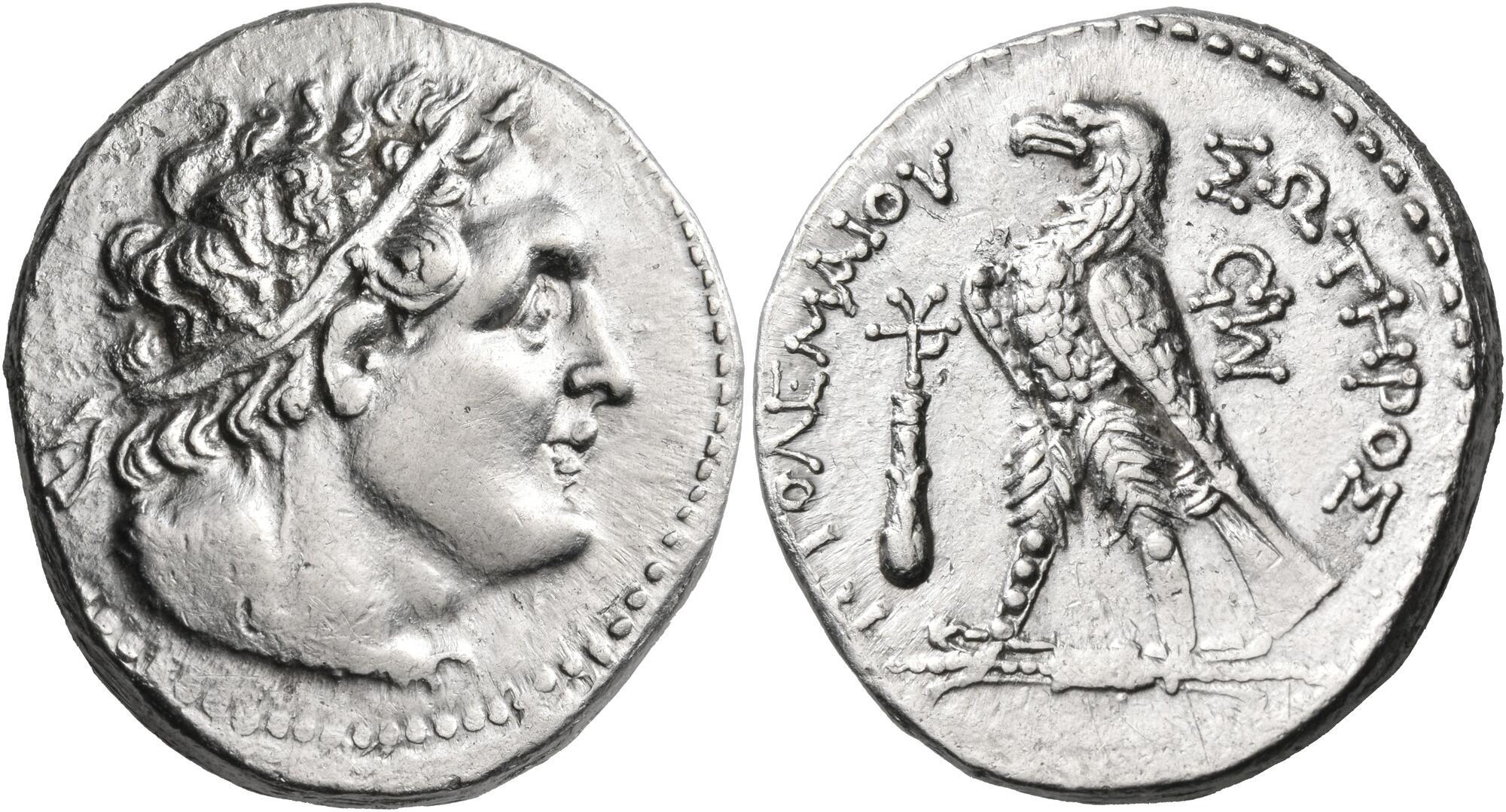Tyre (Ptolemy IV), silver, tetradrachms ΣΩ (portrait of Ptolemy I) (217-215 BCE)
From SILVER
217 BCE - 215 BCE Silver 558 kg
Description
| ObverseInscription or printing placed on the obverse.: | Diademed head of Ptolemy I to right, with aegis tied around his neck |
| ReverseInscription or printing placed on the reverse.: | ΠΤΟΛΕΜΑΙΟΥ ΣΩΤΗΡΟΣ (Greek).Eagle, with closed wings, standing left on thunderbolt, in field to left, monogram of TYP above vertical club, in field to right, monogram of ΣΩ |
Mint and issuing power
| MintIdentifies the place of manufacture or issue of a numismatic object.: | Tyre | Ancient regionAncient region.: | Phoenicia | Modern countryModern country: Lebanon | AuthorityIdentifies the issuing power. The authority can be "pretended" when the name or the portrait of X is on the coin but he/she was not the issuing power. It can also be "uncertain" when there is no mention of X on the coin but he/she was the issuing power according to the historical sources: | Ptolemaic dynasty (323-30 BC), Ptolemy IV Philopator (Ptolemaic king, 221-205 BC), Ptolemy I Soter (satrap and Ptolemaic king of Egypt, 323-305 BC) |
Chronology
| FromIdentifies the initial date in a range assigned in a numismatic context. | 217 BCE | toIdentifies the final date in a range assigned in a numismatic context.. | 215 BCE | PeriodTime period of the numismatic object.: Hellenistic 323-30 BC |
Physical description
| MetalThe physical material (usually metal) from which an object is made.: | Silver |
Median weightMedian of the weights of numismatic objects (in grams). in grams | 14.10 | DenominationTerm indicating the value of a numismatic object. Examples: tetradrachm, chalkous, denarius.: | tetradrachm |
StandardStandard.: | Ptolemaic |
Image

Tyre Ptolemy IV tetradrachms SO.jpg [1]
References
| Die study referencePublication of the study: | Carlen 20221Carlen 2022, p. 56-57, n° 1-29 | ||
| Coin series referenceReference to coin series study: | Sear II2Sear II, n° 7837, CPE I3CPE I, n° 926-928 | ||
| Coin series web referenceCoin series web references: | |||
Obverse dies distribution
| FrequencyFrequency of specimen in distribution. ᵖ | Number of obversesNumber of obverse dies. ᵖ (o) | % (o) | Number of coinsNumber of coins. (n) | % (n) | Die nameName(s) of the die(s). |
| 12 | 1 | 50 | 12 | 41.38 | 1 |
| 17 | 1 | 50 | 17 | 58.62 | 2 |
| Total | 2 of 2 | 100 | 29 of 29 | 100 |
Reverse dies distribution
no distribution is available
Quantification
| Number of obversesNumber of obverse dies. ᵖ (o) | 2 | Number of singletons (o1)The number of singleton coins. ᵖ | |
| Number of reverse diesNumber of reverse dies. (r) | 13 | Number of coinsNumber of coins. (n) | 29 |
| Coins per obverse dieNumber of coins per obverse die. (n/o) | 14.5 | Coins per reverse dieNumber of coins per reverse die. (n/r) | 2.23 |
| Reverse per obverse ratioRatio of obverse dies divided by reverse dies. (r/o) | 6.5 | Percentage of singletons (o1)number of coins (n) divided by the number of singletons (o1) ᵖ | % |
| Original number of dies (O) (Carter 1983 formula)The estimation of the number of coins according to Carter 1983 ᵖ | 1.98 | Coins struck if 20,000 as average productivity per dieCoins made if the average productivity for obverses (according to Carter) is 20,000. ᵖ | 39,600 |
| Original number of dies (O) (Esty 2011 formula)The estimation of the number of coins according to the singleton formula in Esty 2011 ᵖ (O) | 2.15 | Survival rate if 20,000 as average productivity per dieSurvival rate if average productivity is 20,000. ᵖ | 0.00073 |
| Coverage (o = % of O) (Esty 1984 formula)Esty 1984 - coverage (% of O) ᵖ (o = % of O) | % | Die productivity if survival rate 1/2,000Average productivity if survival rate is 1/2,000. ᵖ | 29,292.93 |
| Weight of silver (in kg) if 20,000 coins per die (O = Carter formula)Carter 1983 * Median weight * 20000 (*10 if gold or electrum) ᵖ | 558 kg <br /> 558 kg | Die productivity if survival rate 1/5,000Average productivity if survival rate is 1/5,000. ᵖ | 73,232.32 |
Remarks
Most likely one single workstation Certainly military
References
- ^ Carlen, Eric (2022), "The Silver ΣΩ Coinage of Ptolemy IV and Related Issues," Israel Numismatic Research, 17, p. 51-69.
- ^ Sear, David R. (1979), Greek coins and their values. Vol. II, Asia and North Africa, London, xlviii, p. 317-762
- ^ Lorber, Catharine C. (2018), Coins of the Ptolemaic empire : Part I. Ptolemy I through Ptolemy IV, 2 vol., New York.